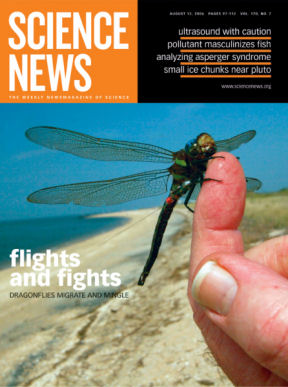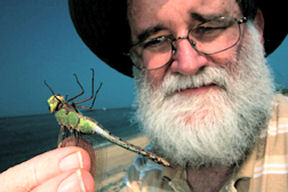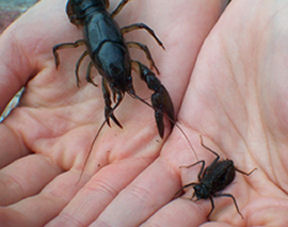When Martin Wikelski and David Wilcove went bird-watching in Cape May, N.J., one fall day in 2004, they were surprised to find that the main spectacle had four wings instead of two. Migrating dragonflies filled the air, flashing iridescent green and blue as they hovered over dunes, perched, then zipped off.



“They were everywhere,” says Wikelski, who’s a biologist at Princeton University. He and his Princeton colleague Wilcove had come to admire birds that take a break on the long haul up and down the East Coast, but insects on long journeys need rest stops too.
Wikelski has studied bird migration and pioneered the tracking of individuals on long flights. He says that as he and Wilcove marveled at the dragonfly air show along the New Jersey coast, they thought, why not track them too?
The scientists knew the difficulties that they were likely to face. Even the newest, lightest tracking devices might weigh down the insects so much that they couldn’t get off the ground. Or the dragonflies might simply refuse to keep migrating after a scientist had glued baggage onto them.
“We knew people would think this was a crazy idea,” Wikelski says.
He and his colleagues have now published an account of their efforts. It’s one of several recent works exploring hard-to-see aspects of dragonfly life.
Although dragonflies are among the most familiar of insects, science is just beginning to unravel their complex life stories, which start in water and end in air. That cycle sends dragonflies into clashes and coalitions with an unusually wide range of other creatures.
Beyond the satisfaction in discovering details of the lives of charismatic animals, the new approaches to dragonfly ecology have implications for conserving these creatures and the wetlands they rule.
What’s up?
Migration biologists have spent decades tracking animals en masse. Wikelski contends that what’s needed now is an individual bird’s-eye view, or bug’s-eye view, of how migration works.
The migrant dragonflies that Wikelski set about tracking were the common green darners (Anax junius), robust fliers with blue abdomens that turn purple as the temperature rises.
Of the 5,200 species of dragonflies and related damselflies in the world, scientists estimate that 25 to 50 make seasonal migrations. There’s evidence for migrations among nine North American species.
These aren’t migrations in the bird sense of the word. Each insect makes a one-way trip and another generation returns, scientists presume.
To follow single dragonflies, Wikelski decided on radio tracking.
He sought help from Jim Cochran of Sparrow Systems in Fisher, Ill., who built ultralight transmitters. “Each one of them is like a Stradivarius,” says Wikelski.
To test a transmitter, which costs about $200, Wikelski and his colleagues fastened it on a female dragonfly’s underside with a nontoxic glue—eyelash adhesive.
Wikelski recalls some nervous moments watching the dragonfly right herself on her perch. The transmitter may be light, but it’s still about one-third the weight of a dragonfly itself.
Finally, the transmitter-bearing dragonfly took to the air—and stayed aloft. The team was exuberant. “It was like the launching of the space shuttle; everyone was jumping up and down,” Wikelski says.
In all, the researchers attached transmitters to 14 dragonflies.
The researchers followed the insects from the ground as best they could with chase vehicles. At least twice a day, Wikelski got a better view by taking off in a small airplane to locate the insects.
The group followed the individual dragonflies for an average of 6 days, in which the insects covered about 60 kilometers.
On any given day, the insects either made one long flight of up to 6 hours or stayed in one area. “They behave like birds,” says Wikelski.
They also stayed put on days when wind speeds topped 25 km per hour, even if the gusts would have swept them along their way.
In the Sept. 22 Biology Letters, Wikelski’s group describes radio tracking individual dragonflies. Now, the team is calling for a bigger effort, including a satellite dedicated to tracking small animals.
Elusive ladies
Sophie Foster, now at the University of Toronto at Mississauga, has studied the Hine’s emerald dragonfly (Somatochlora hineana) in Wisconsin. Although it doesn’t migrate, there were plenty of questions about its movements. Such as where the females hang out when they’re not mating.
In 1995, the federal government listed the Hine’s emerald dragonfly as endangered. It survives in patches in the Midwest. Foster studied in Wisconsin’s Door County in 2000. She worked with Daniel Soluk, who is now at the University of South Dakota in Vermillion.
The emerald dragonfly males patrol breeding grounds near spring-fed streams. For years, biologists have speculated on why there are so few females in many male territories.
Scientists have proposed various answers, such as die-offs of females or refuges for them in other locations. But Foster found no published tests of any of these ideas.
She and Soluk first wondered whether the missing emerald dragonfly females had ever existed. Dragonflies of that species, like others, start life as eggs in water. They hatch into small aquatic creatures that prey voraciously on other little aquatic creatures. Dragonflies in the final larval form pull themselves out of the water unto a perch, such as an overhanging twig and shed their skin.
To get a tally of the sexes of the maturing insects, Foster scoured the edges of wet patches in the Wisconsin woods, looking for the cast-off skins, or exuvia. “The larvae are impossible to find,” she says.
A barely distinguishable dot on an exuvium’s underside indicates that it came from a male. Foster found approximately the same numbers of exuvia from males and females, indicating that the sexes reached adulthood in equal numbers.
To determine the whereabouts of adults, Foster organized simultaneous dragonfly chases in the wet breeding grounds and in nearby dry areas, such as meadows, that might work as female sanctuaries.
The surveyors found less than half as many females in the wet areas as in the neighboring dry ones and twice as many males in the breeding areas as in the meadows.
The researchers also hung out strips of flypaper to see whether the females were staying in areas providing more food. However, the wet areas actually offered better dining. Foster and Soluk reported their findings in the January Biological Conservation.
Foster speculates that sexual harassment might have driven females to avoid the male-dominated turf. Dragonflies have attracted the interest of biologists studying conflicts within and between the sexes.
Males of several dragonfly species are known to sabotage each other’s mating attempts by scraping previously deposited sperm out of a female’s reproductive tract before delivering their own. Many males guard their mates, even dragging a female around by her neck after mating.
In Hine’s emeralds, Foster has seen importunate males trying so relentlessly to mate that they force a female to the ground. Even females that cooperate can spend more than an hour in an encounter. “That seems like a really long time to monopolize a female,” says Foster.
On the basis of these observations, Foster speculates that males may interfere so much with a female’s search for food and other activities that females stay away from the guy zone unless specifically seeking a mate and laying eggs. “I couldn’t help but draw parallels with going to a bar,” Foster says.
The finding “illustrates that wetland species aren’t just wetland species,” she says. It highlights the importance of conserving areas that are dry as well as those typically considered dragonfly habitat.
Swim with the devil
While Foster looked for missing females, Lauren Pintor and Soluk were investigating a question that might have seemed—at first—like a no-brainer: Were crayfish that eat young Hine’s emerald larvae bad for the long-term survival of the endangered species?
Red devil crayfish share the wetlands where Hine’s emerald dragonflies live. The crayfish, with streaks of brilliant red on their claws, excavate stream-bank burrows, where they hollow out chambers that hold little pools even in dry weather. The last part of their scientific name, Cambarus diogenes, honors the Greek philosopher Diogenes, who took to living in a tub.
Pintor says that she started wondering about those crayfish after a drought left the dragonfly habitat dry for several weeks. “When the habitat was flowing with water once again, many of the Hine’s emerald larvae were alive and well,” she says. She began trying to figure out how they had survived.
The last wet places around had been the crayfish burrows. Those would have been puzzling refuges for dragonfly larvae, however, since they’d seem to be likely death zones.
A different picture emerged when Pintor tracked the larvae both in crayfish burrows and in the streams themselves. When water was abundant and ran in the streambeds, more larvae showed up there than in the burrows, she found. But, as the water channels dried up, larvae populations grew in the burrows.
The crayfish structures provide a life-saving refuge for dragonfly larvae during summer droughts, even though some probably get eaten there, Pintor, now of the University of California, Davis and Soluk report in the July Biological Conservation. Without this information, Pintor notes, well-meaning conservation managers might have culled the crayfish in the dragonfly’s habitat, inadvertently dooming many larvae.
Wetland wide web
Dragonflies are predators as well as prey. A study of ponds in northern Florida reveals an intricate cascade of effects. Tiffany Knight, now of Washington University in St. Louis, and her colleagues compared fishfree ponds with fish-filled ones.
Fewer than half as many dragonflies flitted around the fish-filled ones as around the fish-free ones, say the researchers. Fish readily eat dragonfly larvae, Knight explains. Female dragonflies may shy away from fish-filled waters when choosing sites to lay eggs.
The size of pond-side dragonfly populations affects other creatures, Knight proposes. Dragonflies in the Southeastern United States, according to an earlier study, hunt bees. If pollen is a limiting factor for flower propagation, a bee shortage reduces plants’ success.
The researchers monitored pollinators visiting shrubby St. John’s worts and broadleaf arrowhead plants near the edges of ponds. More pollinators, and in particular more bees, buzzed around the plants beside the fish ponds than around the plants at fishfree ponds.
To see whether the difference could affect the plant, Knight added pollen to some of the flowers. Both species set more seed when Knight visited them, a sign that pollen was a limiting factor. The limitation showed up especially strongly in the plants beside ponds with no fish.
Acting through the dragonflies, fish are driving the reproductive success of nearby land plants, Knight and her colleagues concluded in the Oct. 6, 2005 Nature. The wet-dry dragonfly lifestyle links the aquatic food web to the terrestrial one.
Wetlands themselves are disappearing fast, and the international body that tracks the fate of species, the International Union for the Conservation of Nature and Natural Resources, or IUCN, has raised concerns about more than 100 species of dragonflies and damselflies.
It’s clear, though, that Internet-connected, international fan clubs focused on dragonflies aren’t in peril. There are also booming populations of dragonfly earrings, fabric patterns, and even Christmas lights. If some of the flesh-and-blood dragonflies become rare, they’re among the few insects that people might miss.






